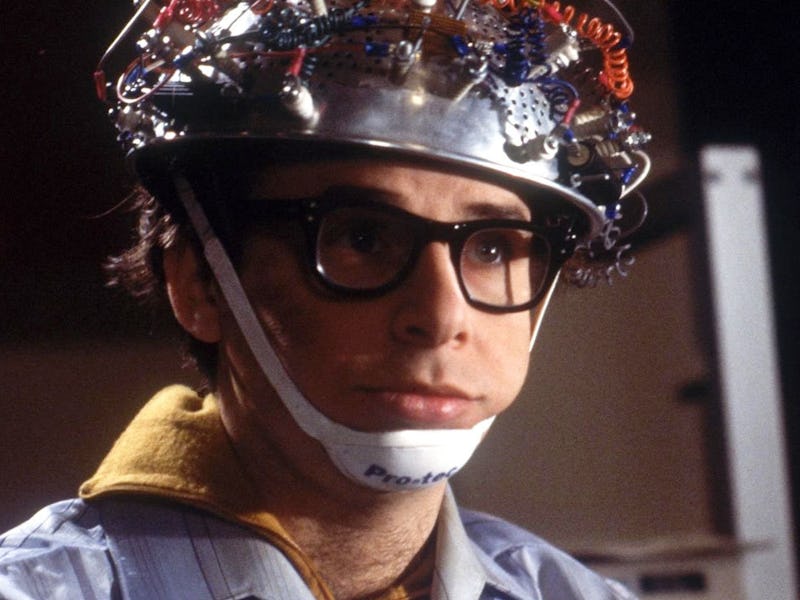The Real-Life Ghostbusters of the Brain
A team of neuroscientists are out to prove that ghostly encounters are all in our heads.

“In a sense, we are absolutely the ghosts we are sensing,” Giulio Rognini, Ph.D., a senior scientist at EPFL’s Laboratory of Cognitive Neuroscience, says.
Rognini is part of a team of researchers at Switzerland’s Ecole Polytechnique Fédérale de Lausanne that might be best described as the real-life ghostbusters. The team is attempting to understand what makes our brains want to believe that apparitions are ghosts.
While he’s more than willing to admit that ghostly sensations are completely real, he’ll be the first to point out that they’re not actually caused by ghosts. In his work, he’s discovered that many such “encounters” are actually caused by a series of brain malfunctions, which trick us into attributing our movements and sensations to someone else.
Rognini’s particular line of research focuses on a particular type of ghost encounter referred to by scientists as the feeling of a presence. “Typically, people report the type of apparition that they see,” Rognini says. “Our kind of apparition is more the sensation that someone is nearby when no one is actually present.” These kinds of encounters are most often reported by people with neurological disorders, like epilepsy and stroke, but they’re also common in people who do extreme, exhausting sports, like long-distance cycling or mountain climbing. If ghosts aren’t real, then what’s triggering these experiences? Rognini and his colleagues — who specialize in investigating the body’s role in subjective experience and self-consciousness — have spent the last decade looking for the source.
In 2006, Olaf Blanke, Ph.D., Director of the Laboratory of Cognitive Neuroscience, was implanting electrodes into the brains of epilepsy patients to investigate the source of the disease. Unexpectedly, he discovered that zapping a specific area of the brain triggered a feeling of a presence in his patients. As he investigated further, he found that the movement of the presence always corresponded to what the patient was doing. If the patient was standing, the presence was standing. If the patient was sitting, the presence was felt as sitting. “There were correspondences between movement and posture between the patient and the presence, showing what we call the sensorimotor aspect of the phenomenon,” Rognini explains. “What was happening was that the patient was misattributing his own signals — his own posture — to the presence.”
In essence, the “ghosts” the patients were sensing were really just echoes of their own movements. When our brains function normally, we have a strong sense of who we are and where we are in space. Processing touch, motor cues, and proprioception — that is, understanding the stimuli our own bodies produce and perceive — all goes smoothly, giving us a firm understanding of how our bodies exist in physical space. By studying people whose brains couldn’t integrate their body’s sensorimotor signals, Rognini and his team concluded that lesions in the parts of the brain crucial to generating the experience of “self” — the temporoparietal, insular, and frontoparietal cortex regions — were the root cause of the feeling of a presence.
An engineer by training, Rognini began a follow-up study by devising a robot to trigger the feeling of a presence in healthy patients. As participants manually controlled the robot’s movements, the robot, in turn, reproduced those movements on the patient’s back, either with or without a small delay. “When there was this small delay, in a way replicating the conflict that is present in neurological patients with brain lesions in areas that integrate body signals, the patient no longer attributes movements and touch to himself,” he explains. Unable to figure out where the movements are coming from, the patient has no choice but to attribute them to someone — or something — else.
Some of the patients in this study, which was described in a 2014 paper in Current Biology, were too freaked out by the robot’s ghostly presence to participate for its entirety and asked to stop the experiment. But the study successfully showed what Rognini was hoping to prove: Ghosts are all in our heads.
“We take for granted that we have a solid representation of our body in space and time,” he says. “I think this feeling of a presence study is a nice example of the fact that when you trick your own bodily signals and you trick your brain at interpreting them, then you can have very very weird, strange sensations.” His next move will be to test his robots on patients inside an MRI scanner in order to pinpoint the specific parts of the brain that are chasing phantoms.
Of course, Rognini is aware that his model can’t explain all of the different ghosts humans have claimed to encounter. “The literature on ghosts and apparitions and hallucinations is huge and also highly influenced by culture,” he says, explaining that his experiment provides a scientific account of only a small sliver of the supernatural. Can science suggest an explanation for everything else? Even Michael Shermer, notorious science cynic and founding publisher of Skeptic magazine, has admitted he’s been forced to consider the existence of the supernatural. If you ask Rognini, he’ll admit that his work only goes so far.
“We cannot, of course, explain out all the apparitions that have been reported.”